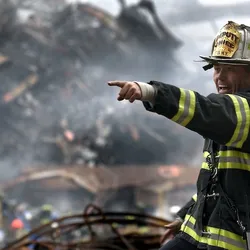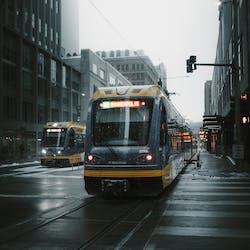
Level 1:
A big fire happened in a tall building in Johannesburg. Many people lived there without permission. The fire was very strong, like a big oven. The building had many small rooms, and it was hard to escape. The firefighters had trouble helping. More than 70 people died, and others got hurt. Some jumped out of the burning building. Kids also got hurt. The fire was in the cold time. People lit fires to stay warm, but this fire was too big. The building was old and broken, and it was a home for people who didn’t have one. Many people in the city live like this.
The fire is very sad. Kids also died. A firefighter said it was the worst he saw. The building was not safe, and people were not happy there. The cold makes people do things to keep warm. But sometimes, bad things happen. Many buildings are not safe for living. People need better places to live. This is a big problem in Johannesburg. People must help each other. They should not forget the bad thing that happened. They must find ways to keep everyone safe.
Level 2:
A huge fire happened in a tall building in Johannesburg. People were living there without permission. The fire was very strong, like a big oven. The building had many small rooms, and it was hard to get out. The firefighters had trouble helping. More than 70 people died, and others got hurt. Some jumped out of the burning building. Kids also got hurt. The fire was during the cold time. People lit fires to stay warm, but this fire was too big. The building was old and broken, and it was a home for people who didn’t have one. Many people in the city live like this.
The fire is very sad. Kids also died. A firefighter said it was the worst he saw. The building was not safe, and people were not happy there. The cold makes people do things to keep warm. But sometimes, bad things happen. Many buildings are not safe for living. People need better places to live. This is a big problem in Johannesburg. People must help each other. They should not forget the bad thing that happened. They must find ways to keep everyone safe.
Full Story:
A deadly fire tore through a five-story building in Johannesburg, South Africa, leaving over 70 people dead. The tragic incident has cast a grim spotlight on the dire living conditions faced by squatters who had taken refuge in the building.
The building, located in the heart of Johannesburg’s central business district, had become a makeshift home for squatters who lacked proper housing options. These informal settlements, composed of makeshift shacks and structures, bore witness to the unforgiving flames that engulfed the building. Many occupants struggled to escape the inferno due to the maze of debris and structures, complicating the rescue efforts of the firefighters.
The toll the blaze exacted is nothing short of harrowing. At least 73 individuals lost their lives, and it is feared that this count will rise as rescue operations continue. More than 50 people were injured, some resorting to desperate leaps from the burning building to save their lives.
Among the deceased are seven children, including a 1-year-old, a heartrending reminder of the innocent lives caught in the tragedy. Robert Mulaudzi, a spokesperson for Johannesburg Emergency Services Management, expressed the gravity of the situation, saying, “Over 20 years in the service, I’ve never come across something like this.”
The building where the fire erupted had been one of many that were effectively “hijacked” by squatters due to the scarcity of affordable housing in Johannesburg. These dilapidated structures, often housing undocumented immigrants seeking shelter, stand as stark symbols of the housing crisis plaguing the city.
As the South African winter sets in, the harsh cold drives desperate measures. Mgcini Tshwaku, a Johannesburg city councilman, shed light on the stark reality that many resort to lighting fires for warmth within these informal settlements. The question that looms is whether the desperation to stay warm inadvertently led to the inferno that claimed so many lives.
This tragedy highlights the urgent need for affordable housing solutions in Johannesburg. The hijacked buildings, like the one consumed by fire, are a glaring indication of the systemic issues that must be addressed. The incident prompts us to ponder: How can a city with such vibrant economic prospects fall short in providing basic living conditions for its residents? What measures are being taken to prevent such catastrophes in the future?
Moreover, this catastrophe calls into question the broader concerns of urban planning and safety regulations. Could more robust safety measures have prevented such a devastating loss of life? Are there contingency plans in place to swiftly respond to emergencies in these informal settlements?
The somber reality is that this tragedy is not an isolated incident. It is a stark reminder of the challenges faced by marginalized communities living on the fringes of society. The lack of proper housing options, coupled with limited access to resources and opportunities, perpetuates a cycle of vulnerability.
As we extend our thoughts and condolences to the victims and their families, we must also demand accountability from the authorities and seek tangible solutions to prevent such heartbreak in the future. The blaze that ravaged through the squatter building in Johannesburg serves as a distressing wake-up call, urging us to confront the uncomfortable truths about societal neglect and the urgent need for change.
In the aftermath of this tragedy, we are left grappling with a multitude of questions. How can we ensure that such fires do not claim more lives in the future? How can we break the cycle of poverty and vulnerability that forces individuals into such precarious living situations? And most importantly, how can we, as a society, rise above complacency to ensure that every individual has access to safe and dignified housing?
The fire in Johannesburg is a tragic event that demands more than just our empathy. It requires a united effort to address the systemic issues that allowed it to happen. It is a call to action to prioritize the well-being and safety of all residents, regardless of their socio-economic status. Only through a collective commitment to change can we hope to prevent such devastating incidents from occurring again.
Questions:
Question: What caused the fire in the building in Johannesburg?
Answer: The fire in the building in Johannesburg was caused by a strong blaze that engulfed the structure. The building had become a home for people without permission, and many of them were living in small rooms inside. They used fires to keep warm during the cold time, which might have led to the fire becoming too big to control. The article mentions that the building was old and broken, and this combination of factors likely contributed to the tragedy. While the exact cause isn’t stated explicitly, the article suggests that the fire was an unfortunate outcome of the living conditions and the attempts to stay warm within the building.
Question: How did the firefighters respond to the fire in the building?
Answer: The firefighters worked hard to control the fire that broke out in the building in Johannesburg. They faced challenges due to the maze-like layout of the building and the debris inside, which made it difficult for people to escape and for the firefighters to navigate. Despite these obstacles, the firefighters were on the scene for over three hours to contain the fire. However, due to the intense nature of the blaze and the obstacles in the building, they weren’t able to prevent a high number of casualties. Their efforts were commendable, but the building’s conditions and the rapidly spreading fire posed significant challenges to their rescue operation.
Question: Why did people live in the building without permission?
Answer: People were living in the building in Johannesburg without permission because they lacked proper housing options. The article describes the building as one of many “hijacked” buildings where squatters took refuge due to the scarcity of affordable housing in the city. These buildings, often dilapidated and unsafe, became homes for those who didn’t have other places to live. Many of the occupants were undocumented immigrants facing socio-economic challenges. The building provided a shelter of necessity, highlighting the deeper issue of inadequate housing and the vulnerability of marginalized communities.
Question: What are the concerns about informal settlements and their safety?
Answer: Informal settlements, like the one in the building in Johannesburg, raise significant safety concerns. These settlements are often made up of makeshift structures and lack proper infrastructure and safety measures. The article mentions that the building had many shack-like structures inside, making it hard for people to escape the fire. This lack of proper design and safety precautions puts inhabitants at risk in case of emergencies. The tragedy underscores the need for proper urban planning and regulations to ensure the safety of residents in such settlements. Without these measures, the cycle of vulnerability and risk continues for those who have no other housing options.
Question: What message does this incident convey about housing issues and societal responsibility?
Answer: The incident in Johannesburg delivers a powerful message about the dire housing issues and societal responsibility. The tragedy highlights the desperate circumstances that force people to live in unsafe and makeshift conditions, as evidenced by the building’s occupation by squatters. The lack of affordable housing options, especially for marginalized communities and undocumented immigrants, contributes to this problem. This incident calls for a collective effort from both authorities and society to address housing disparities, improve living conditions, and ensure the safety and well-being of all residents. It raises questions about how cities can prioritize providing dignified and secure housing for all, underscoring the need for social change and better policies.
Fill in the Blanks:
dilapidated, maze, prioritize, harrowing, dignified, debris, complicating, confront, scarcity, inadvertently, complacency, plaguing, squatter, collective, distressing, marginalized, precarious, undocumented, systemic, united, accountability, Squatter, cycle, empathy, desperate, neglect, inferno
Title: “Tragedy Strikes Johannesburg as Fire Engulfs ________ Building, Claiming 70+ Lives”
In a heart-wrenching incident that unfolded in the early hours of Thursday, a deadly fire tore through a five-story building in Johannesburg, South Africa, leaving over 70 people dead.
Many occupants struggled to escape the ________ due to the ________ of ________ and structures, ________ the rescue efforts of the firefighters.
The toll the blaze exacted is nothing short of ________.
More than 50 people were injured, some resorting to ________ leaps from the burning building to save their lives.
Robert Mulaudzi, a spokesperson for Johannesburg Emergency Services Management, expressed the gravity of the situation, saying, “Over 20 years in the service, I’ve never come across something like this.”
The building where the fire erupted had been one of many that were effectively “hijacked” by squatters due to the ________ of affordable housing in Johannesburg.
These ________ structures, often housing ________ immigrants seeking shelter, stand as stark symbols of the housing crisis ________ the city.
The question that looms is whether the desperation to stay warm ________ led to the inferno that claimed so many lives.
The hijacked buildings, like the one consumed by fire, are a glaring indication of the ________ issues that must be addressed.
It is a stark reminder of the challenges faced by ________ communities living on the fringes of society.
The lack of proper housing options, coupled with limited access to resources and opportunities, perpetuates a ________ of vulnerability.
As we extend our thoughts and condolences to the victims and their families, we must also demand ________ from the authorities and seek tangible solutions to prevent such heartbreak in the future.
The blaze that ravaged through the ________ building in Johannesburg serves as a ________ wake-up call, urging us to ________ the uncomfortable truths about societal ________ and the urgent need for change.
How can we break the cycle of poverty and vulnerability that forces individuals into such ________ living situations?
And most importantly, how can we, as a society, rise above ________ to ensure that every individual has access to safe and ________ housing?
The fire in Johannesburg is a tragic event that demands more than just our ________.
It requires a ________ effort to address the systemic issues that allowed it to happen.
It is a call to action to ________ the well-being and safety of all residents, regardless of their socio-economic status.
Only through a ________ commitment to change can we hope to prevent such devastating incidents from occurring again.
Vocabulary:
Squatter: A person who lives in a building or on a piece of land without permission or legal right.
Inferno: A very large and dangerous fire that causes a lot of destruction.
Maze: A confusing network of paths or passages, often difficult to navigate.
Debris: Scattered pieces of waste, remains, or fragments from something that has been destroyed.
Complicating: Making a situation more difficult or complex.
Harrowing: Extremely distressing or upsetting.
Desperate: Feeling a sense of urgency or extreme need.
Inadvertently: Accidentally or unintentionally.
Scarcity: A shortage or lack of something.
Dilapidated: In a state of disrepair or decay, often due to age or neglect.
Undocumented: Without proper legal documents or authorization.
Plaguing: Causing problems or troubles for a prolonged period.
Vulnerable: Easily harmed or at risk, often due to lacking protection or resources.
Complacency: A state of being satisfied with the current situation, often leading to a lack of action or effort.
Wake-up call: An event or experience that prompts awareness and action, often in response to a problem.
Precarious: Unstable, uncertain, or risky.
Marginalized: Pushed to the edges or margins of society, often experiencing exclusion or discrimination.
Cycle: A repeated sequence or pattern.
Systemic: Relating to or affecting an entire system, often referring to issues deeply rooted in a system’s structure.
Accountability: The responsibility to answer for one’s actions and decisions.
Socio-economic: Relating to the social and economic factors that influence the well-being of individuals and communities.
Collective: Involving a group of people working together towards a common goal.
Empathy: The ability to understand and share the feelings of another person.
Prioritize: To give more importance or attention to something over others.
Dignified: Showing a sense of self-respect and worthiness.
Committed: Fully dedicated and engaged in a task or cause.
Confront: To address or deal with a difficult or challenging situation directly.
Neglect: Failure to provide proper attention, care, or consideration.
United: Together in harmony or agreement.
Distressing: Causing feelings of sadness, anxiety, or discomfort.




